#Borodyanka Ukraine
Photo


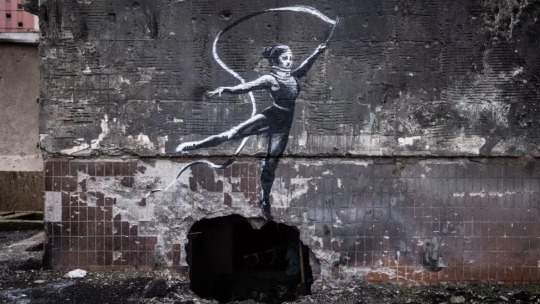
Banksy Unveils Mural in Ukrainian town liberated from Russians
Renowned street artist Banksy has unveiled his latest artwork in an Instagram post – a mural in the liberated Ukrainian town of Borodianka.
The artwork shows a female gymnast balancing on a pile of rubble on the side of a building damaged by Russian strikes.
The graffiti artist posted three images of the piece Friday on social media, with a simple caption reading “Borodyanka, Ukraine,” using an alternative spelling for the town’s name.
Speculation had been mounting that Banksy was in the war-torn country after a series of murals appeared in Borodianka, located about 35 miles northwest of the capital, Kyiv.
One artwork, not officially claimed by the artist, depicted a man being flipped during a judo match with a little boy.
Another showed two children using a metal tank trap as a seesaw.
Borodianka was hit particularly hard by Russian airstrikes at the start of the invasion of Ukraine in February, with many buildings reduced to piles of rubble by long-range attacks.
It was home to 13,000 people before the war, but most fled after Russia’s invasion. What was left of Borodianka, after intense shelling and devastating strikes, was then occupied by Russian forces, who moved in on February 28.
The town came back into Ukrainian control on April 1, and returning residents found their houses ransacked and shops pillaged with windows broken and contents stolen.
The letter “V” – a symbol used by Russia’s Eastern Military district in concert with the letter “Z,” an emblem for Moscow’s so-called “special military operation” – was found painted on buildings, vehicles and checkpoints.
The town has since been the focus of reconstruction efforts, with several tower blocks demolished as a result of damage caused by the fighting.
#Bansky#Banksy Unveils Mural in Ukrainian town liberated from Russians#Borodianka#Borodyanka Ukraine#graffiti artist#street artist#art#artist#art work#art world#art news#ukraine#russia#z#v#war#world at war#peace#peace for all#peace for ukraine
47 notes
·
View notes
Text
Banksy confirma haber hecho 7 murales en Ucrania 🇺🇦
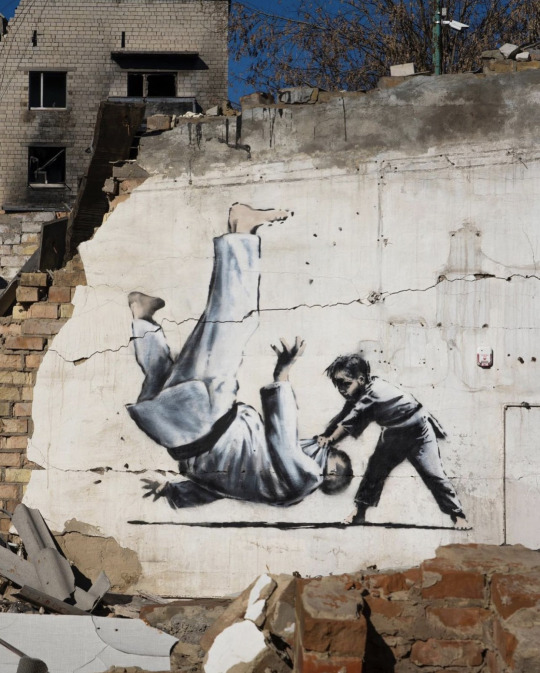
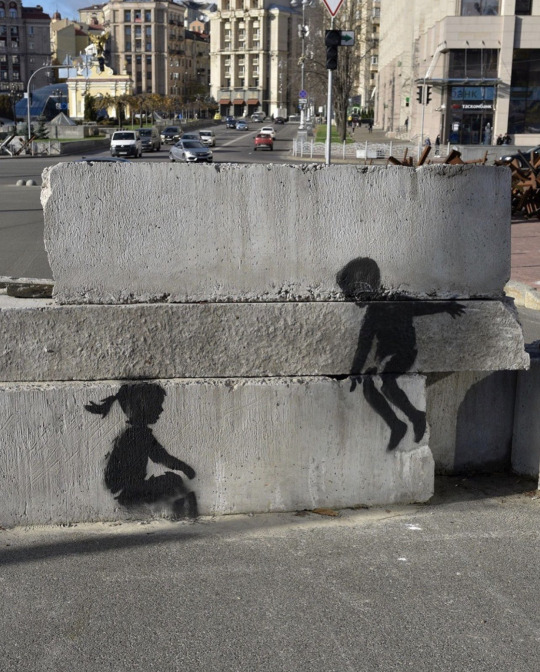

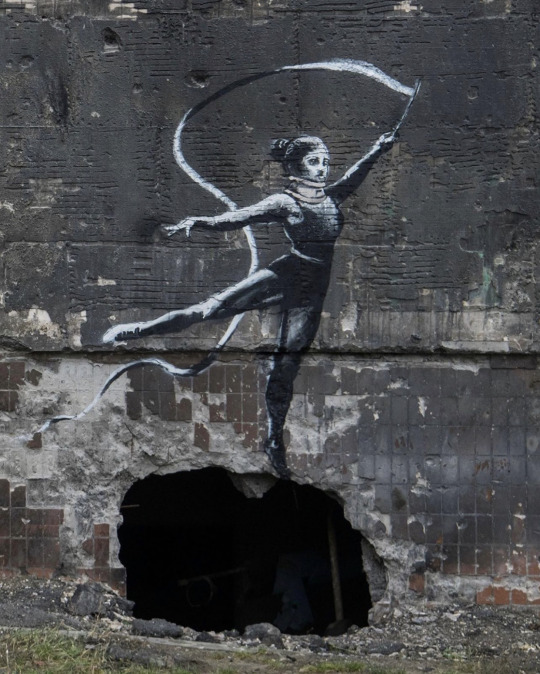
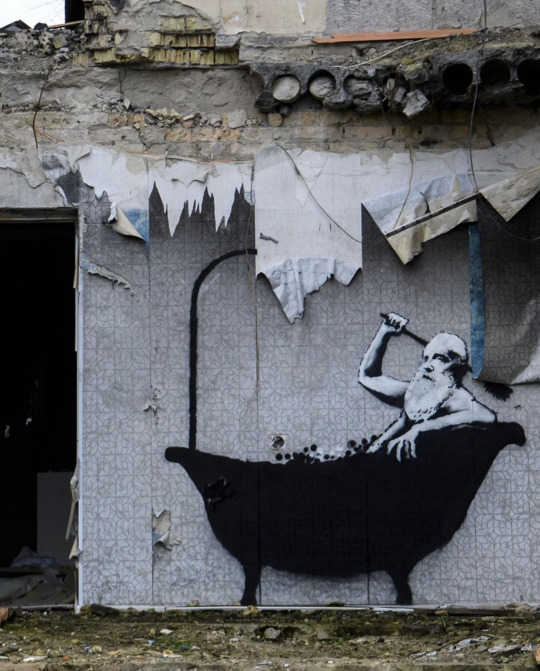

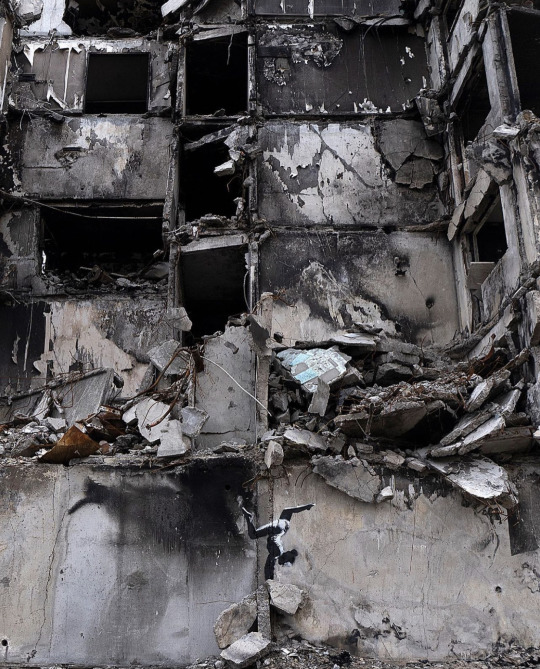

Tras haber publicado una foto en Borodyanka, el anónimo artista callejero ha confirmado que ha realizado estos otros 7 murales.
#sfw#noticia#banksy#art#arte#artist#artista#graffiti#grafitti#mural#murals#paint#draw#ucrania#ucraine#ukraine#ukrayna#borodyanka
255 notes
·
View notes
Text
Banksy in Borodyanka




#ukraine#war in ukraine#borodyanka#banksy#street art#art#banksy in ukraine#stand with ukraine#we will win#street art in ukraine#pray for ukraine
32 notes
·
View notes
Photo

from IG banksy and banksy.co.uk - 17th November 2022
Borodyanka, Ukraine



2 notes
·
View notes
Text
instagram


2 notes
·
View notes
Photo


Borodyanka, Ukraine
1 note
·
View note
Text
For many spared the direct impacts of the war in Ukraine, the conflict has become a distant concern — distressing and unsettling, yet no longer disruptive to daily life. To bring awareness back to the war’s human cost, Russian visual artist Danila Tkachenko installed enlarged photographs documenting the destruction next to famous landmarks in eight European cities, and then photographed Ukrainian refugees against the backdrop of these images. Meduza shares the project, titled “Inversion.”
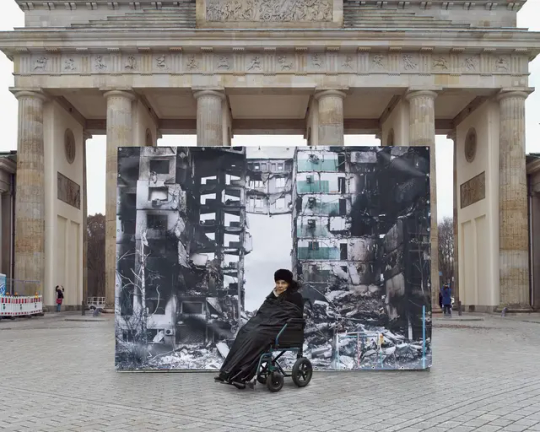
Olena, a 92-year-old former teacher, against the backdrop of a photograph showing a destroyed apartment building in Borodyanka, Kyiv region. The photograph, taken by Maxim Dondyuk, was placed in front of the Brandenburg Gate in Berlin, Germany.
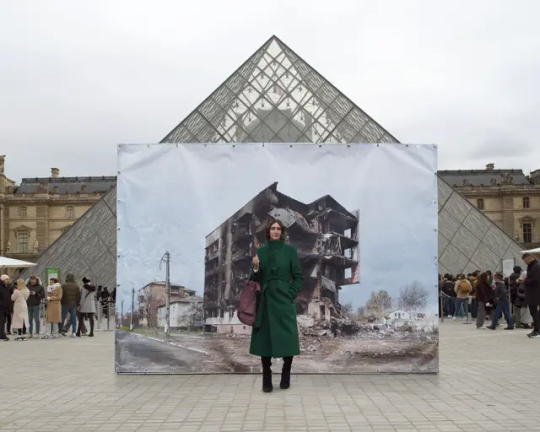
Twenty-five-year-old model Viktoriia stands in front of a photograph showing another destroyed apartment building in Borodyanka. Captured by photojournalist Yuliа Ovsyannikova, the image was displayed by the Louvre Pyramid in Paris, France.

Two-year-old Alina is held by her mother in front of an image of a destroyed bridge in Irpin, Kyiv region. The photograph, taken by Mexican photojournalist Narciso Contreras, was placed on the Charles Bridge in Prague, Czechia.

Fedir, a 32-year-old lawyer, stands before a photograph showing a bombed school in Zhytomyr, Ukraine. The image, captured by Portuguese photojournalist Miguel A. Lopes, was displayed in front of the Colosseum in Rome, Italy.
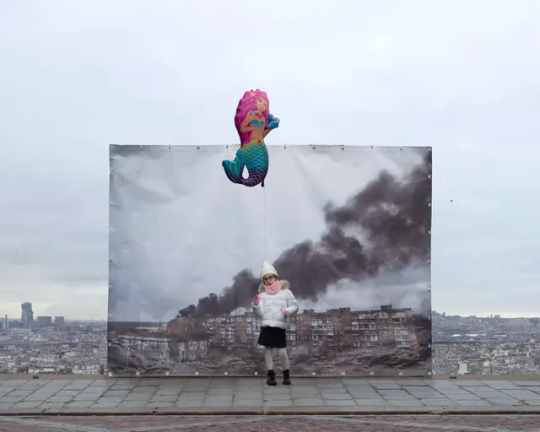
Seven-year-old Khrystyna in front of a photograph of the bombed-out city of Mariupol, taken by Evgeniy Maloletka. The photograph was displayed on Montmartre hill in Paris, France.
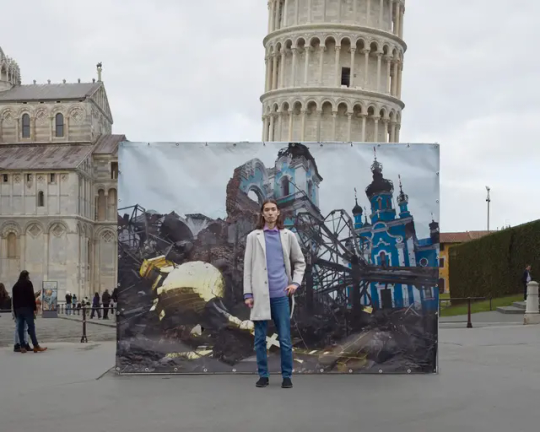
Ivan, a 23-year-old designer, stands in front of a photograph taken by Mykhaylo Palinchak. The image shows a church in the liberated village of Bohorodychne in Ukraine’s Donetsk region. Pisa, Italy.

Anna, a 30-year-old real estate manager, stands in front of a photograph of ruins in Chernihiv, taken by Mykhaylo Palinchak. Paris, France.
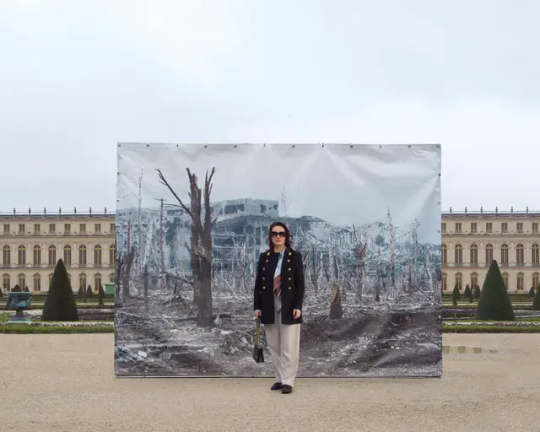
Forty-year-old makeup artist Yuliia stands in front of a photograph of the destroyed Donetsk Airport, taken by Vasily Maximov. Versailles, France.

Nataliia, a 39-year-old editor, stands in front of a photograph taken by Maxim Dondyuk, showing a bombed apartment building in a settlement in Ukraine’s Luhansk region. Milan, Italy.
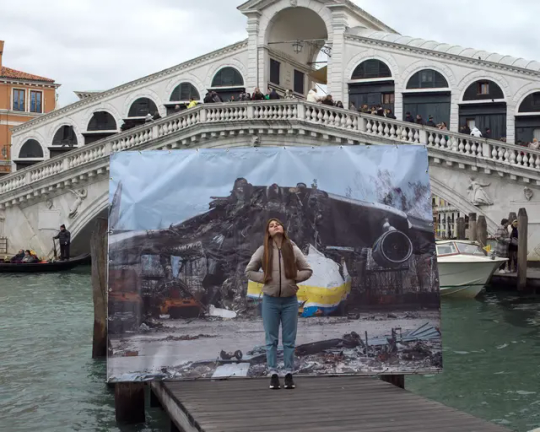
Vladlena, a 25-year-old beautician, stands in front of a photograph of the world’s largest aircraft, Mriya (“dream” in Ukrainian), which was destroyed at the beginning of the full-scale invasion. The photograph, taken by Oleksii Furman, was displayed near the Rialto Bridge in Venice, Italy.
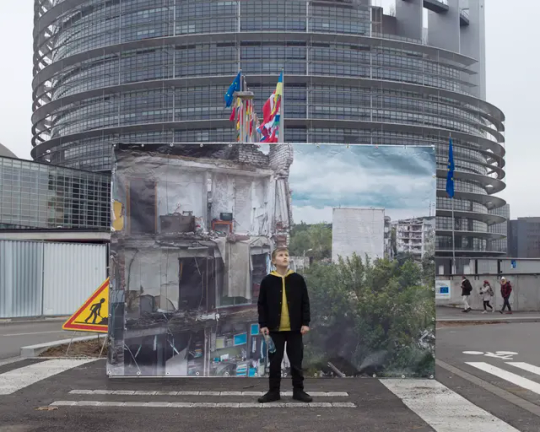
Eleven-year-old Oleksandr against the backdrop of a photograph showing destroyed apartment buildings in Izyum, Kharkiv region, taken by Evgeniy Maloletka. The photograph was placed next to the European Parliament building in Strasbourg, France.
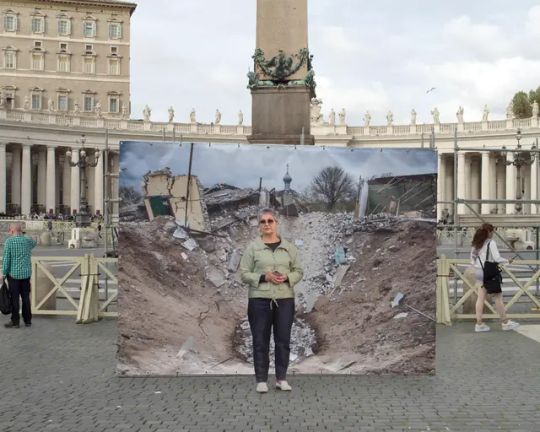
Anna, a 60-year-old dentist, stands in Vatican City in front of a photograph by French photojournalist Laurence Geai, taken in the village of Yatskivka, Donetsk region. Yatskivka was liberated by the Ukrainian Armed Forces in September 2022.
52 notes
·
View notes
Text
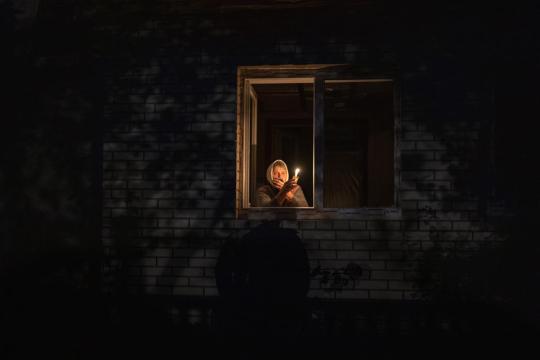
Catherine, 70, looks out the window while holding a candle for light inside her house during a power outage, in Borodyanka, Kyiv region, Ukraine, Thursday, October 20, 2022. Airstrikes cut power and water supplies to hundreds of thousands of Ukrainians on Tuesday, part of what the country's president called an expanding Russian campaign to drive the nation into the cold and dark and make peace talks impossible. (AP Photo/Emilio Morenatti)
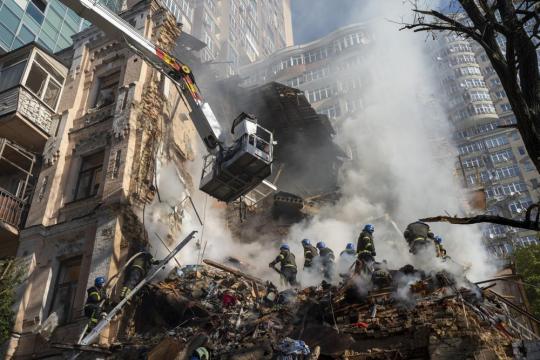
Firefighters work after a drone attack on buildings in Kyiv, Ukraine, Monday, October 17, 2022. Waves of explosive-laden suicide drones struck Ukraine's capital as families were preparing to start their week early Monday, the blasts echoing across Kyiv, setting buildings ablaze and sending people scurrying to shelters. (AP Photo/Roman Hrytsyna)

Mourning in eastern Ukraine on Tuesday, October 18, 2022 at the funeral of a 42-year-old Ukrainian soldier who was killed by shrapnel during fighting. (Finbarr O'Reilly/The New York Times)

Two woman stand next to Ukrainian flags placed in memory of civilians killed during the war at the Independence square in central Kyiv, Thursday, October 20, 2022. (AP Photo/Francisco Seco)
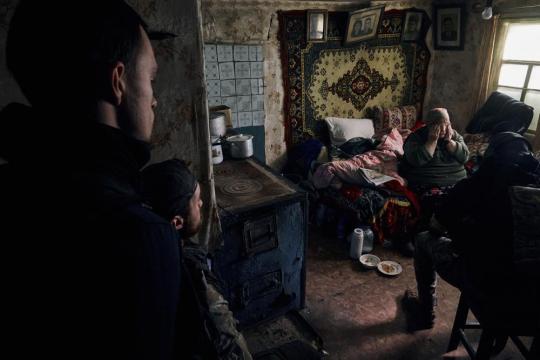
Volunteers urge a local elderly woman to leave her house located in a combat zone in the village of Zarechne, Donetsk region, Monday, October 17, 2022. (AP Photo/LIBKOS)

Damaged ambulances in Bakhmut, in Ukraine’s eastern Donetsk region, on Wednesday, October 19, 2022. The area has faced relentless shelling from Russian forces. (Finbarr O'Reilly/The New York Times)
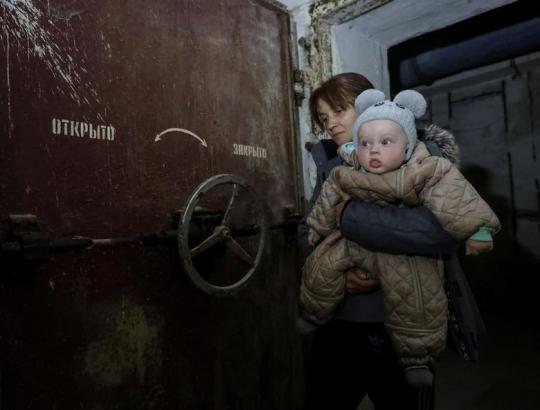
Zhenia, 6-months-old and his mother, Olha Shevchenko, 39, in a bomb shelter in Kharkiv, Ukraine, Thursday, October 13, 2022. Zhenia has lived in a bomb shelter since he was born. (REUTERS/Vyacheslav Madiyevskyy)

Crews working to extinguish fires and search for missing people on Monday, October 10, 2022 after a missile hit a residential building in Zaporizhzhia, Ukraine. (Nicole Tung/The New York Times)

People shop in a supermarket as Kharkiv suffers an electricity outage in Kharkiv, Ukraine, Monday, October 17, 2022. (REUTERS/Clodagh Kilcoyne)

A body lay covered in foil after a Russian strike in Kyiv on Monday, October 10, 2022. In Russia’s largest aerial assault since the early days of the war, missiles rained on at least 11 cities across Ukraine. President Vladimir Putin of Russia said the strike was retaliation for an explosion that destroyed sections of a bridge linking Russia to the Crimean Peninsula on October 8. (Finbarr O'Reilly/The New York Times)
370 notes
·
View notes
Text



Banksy l Borodyanka, Ukraine
Russia's bombing over Borodyanka; one of the biggest tragedies in the Kyiv region of Ukraine, most affected by Russian invasion
#banksy#art#street#street art#graffiti#murals#ukraine#russia#invasion#war#tragedy#russian aggression#Kyiv
142 notes
·
View notes
Text

Banksy artwork appears on damaged building in Borodyanka, Ukraine, bombed by Russia (November 2022). The mural depicts a man resembling the Russian president, Vladimir Putin, being thrown to the floor during a judo match with a young boy.
#banksy#ukraine#street art#political art#anti war#vladimir putin#russian ukrainian war#artwork#artist#art
49 notes
·
View notes
Text
Hello everyone!
This is the first time I run a pet blog so bear with me. My name's Agathiel and this is for my dog, Kim. She's a beautiful mix of Caucasian Shepherd and lord-knows-what (if you have guesses about her breed, feel free to PM me!).
[TW: war, animal abuse, animal death]
Kim was a stray welcomed at Borodyanka, Ukraine. She lived there approximately for 4 years, until the war in Ukraine exploded and Borodyanka was occupied by Russian soldiers, at that point the shelter was isolated and all the dogs were left in their cages without food and water. She and a lucky few survived because they were able to reach some snow and stay hydrated. Then finally volunteers were allowed in the shelter and the amazing Lega per la Difesa del Cane association was able to bring 30 survivors in my country.
[End of TW]
I then met her in my local shelter. I had previously caught a glimpse of her online, but wasn't expecting her to be a "green" (easy, well-balanced) dog. Her eyes struck me, she had the most expressive face I've ever seen in a dog. All the compatibility tests went excellently and she was finally home.
We are now attending an education class to help her overcome her anxiety, she's doing her best and she's the most amazing dog one can hope for.
Hope you enjoy her shenanigans!
This blog is LGBTQ+ friendly and anti-TERFs. Don't be bothered with arguing with that or about the Ukranian-Russian war, I don't have time nor patience for it.



9 notes
·
View notes
Photo

#Streetart (probably) by #Banksy @ #Borodyanka, Ukraine More info at: https://barbarapicci.com/2022/11/11/streetart-banksy-borodyanka-ukraine/ #streetartBorodyanka #streetartukraine #ukrainestreetart #art #graffiti #murals #murales #urbanart #muralism #muralismo #streetarteverywhere #instastreetart #streetartphotography #streetartpics #streetartaddicted #streetartlover #igersstreetart #graffitiart #arteurbana #wallart #spraypaint #spraypaintart #contemporaryart #artecontemporanea https://www.instagram.com/p/Ck05aLaI-n6/?igshid=NGJjMDIxMWI=
#streetart#banksy#borodyanka#streetartborodyanka#streetartukraine#ukrainestreetart#art#graffiti#murals#murales#urbanart#muralism#muralismo#streetarteverywhere#instastreetart#streetartphotography#streetartpics#streetartaddicted#streetartlover#igersstreetart#graffitiart#arteurbana#wallart#spraypaint#spraypaintart#contemporaryart#artecontemporanea
6 notes
·
View notes
Text
The constant boom of artillery in the near distance is the defining feature of life in the Donbas today. As Russia presses its offensive to take the eastern part of Ukraine, the signs of conflict are everywhere: buildings smashed to ruins by cruise missiles, Ukrainian tanks and howitzers on the highway headed east. The Donbas region, encompassed by a front stretching hundreds of miles and currently the scene of the most extensive fighting in Europe since World War II, is in total war mode.
The Russian military machine, which has overwhelming superiority in artillery, is grinding forward slowly but surely, conquering an additional kilometer or two a day at immense cost to the defenders. Exhausted Ukrainian soldiers speak of weeks of fighting under relentless bombardment, heavily outgunned by an opposing force that has recovered from its initial blunders and is now fighting the sort of war it was designed for. Under Vladimir Putin’s leadership, Moscow is pushing on eastern Ukraine a fate much like the one it imposed on another unruly former vassal at the start of Putin’s reign: Chechnya.
The Russian plan for Ukraine is grimly apparent from that earlier template. In a years-long conflict, which began more than two decades ago, Putin destroyed a sovereign state and subjugated its people, creating in its place a land of ruin, chaos, and fear. For that same plan to proceed in Ukraine, a country with a population 40 times the size of Chechnya’s, would be exponentially more ruinous.
The plan unfolds in a few set phases. The first is pacification. This comes quickly where it can, and slowly, via obliteration, where it cannot. In Chechnya, the rapid part took place in most of the outlying areas, the towns and villages that dot the once-picturesque Terek River plain, where Russian forces rolled through in late 1999. In the case of Ukraine, the south was easily overrun; the open terrain and insufficient defenses offered little resistance to the Russian advance that swept through cities such as Melitopol and Kherson in the offensive’s first week.
In other areas, the more lightly armed defenders hold out en masse, especially when they are able to utilize the cover of major urban areas. This necessitates the other main Russian tactic. In the Chechen capital, Grozny—whose very name, chosen by a czarist general, means “terrible” in Russian—the level of bombardment rained down upon the defenders from late 1999 to early 2000 was so great as to gut nearly every building in the city. Its vacant shell was assessed by the United Nations as the “most destroyed city on Earth.” In Ukraine, this fate has been visited upon Mariupol: once a handsome and vibrant city reduced under three months of siege to a smoking ruin.
Occasionally, of course, the defenders must be reminded that their failure to submit unconditionally entails the most severe consequences—not just for the fighters but for their families too. In Chechnya, Russian troops habitually lined up entire civilian populations of villages or neighborhoods for massacre; in the town of Novye Aldy, for example, at least 60 civilians were summarily executed in February 2000. In the suburbs of Kyiv, such as Bucha, Irpin, and Borodyanka, Russian soldiers similarly demonstrated the price to be exacted for resistance.
Once the Russian conquest is complete, a suitable satrap must be found and empowered to rule the natives. Even the Chechens, a people whose spirit of near-unbreakable resistance inspired Russian writers from Tolstoy to Solzhenitsyn, offered up a few candidates. Chief among them was Akhmad Kadyrov, the former grand mufti of Ichkeria, as the independent republic was known. His rule was brief, ended by assassination in 2004, but his remarkably brutal son Ramzan, himself a former rebel, proved an effective substitute. In Ukraine, there have been candidates enough in the already occupied parts of Donetsk and Luhansk, and other, newly captured regions have put forward their own: a local thug who sees a chance for advancement under the new boss or a pliant councilwoman who is willing to provide an ersatz sense of normalcy while the occupiers go rooting out the holdouts.
Finally, the establishment of the new order. Of necessity for a time, the locals will be held down by occupation forces, but they must come to obey their own, to be self-sufficient in their repression. A new apparatus of domination will be constructed, one that sees the vanquished take responsibility for crushing the remaining indigenous resistance. Token incentives will be provided: some Potemkin redevelopment in the style of Grozny’s garish neon skyscrapers or its enormous mosque (for a time the largest in Europe).
The traumatized citizens will be taught a new version of their own history, one in which their absorption into Russian vassaldom was entirely voluntary and, in fact, a salvation from “radicals” and “terrorists” who had sought to destroy them. Eventually, the new generation will be brought up with the idea of service to the Russian motherland as a sacrosanct obligation, under the guidance of a leader who renames the capital’s main avenue after the Russian president and regularly declares himself Putin’s “foot soldier.” Military service in the next round of Russia’s imperial conquests will be not only expected but enforced, with conscription drives hauling off young men from these new territories for whatever the next war is.
Perhaps the most ominous aspect of this plan is the Russian willingness to wait years, if necessary, to enact it fully—even if a seemingly durable truce delays progress toward that goal with a prolonged pause in military operations. The First Chechen War, in the mid-1990s, did not end in Russian victory. That came later, and only after a debacle that saw Russian troops suffer a humiliating defeat in the second Battle of Grozny in August 1996, when groups of well-coordinated Chechen insurgents infiltrated the city and cut off Russian units trapped inside. The blunders of the first month of Russia’s invasion of Ukraine were strikingly similar to those of its initial two-year campaign in Chechnya. Back then, we saw the same absurd political expectations of no resistance—Russia’s then–defense minister, Pavel Grachev, famously claimed that he could take Grozny in two hours with a single airborne regiment—and the same phenomenon of confused, demoralized Russian soldiers deserting their vehicles.
The resulting cease-fire agreement, the Khasavyurt Accords, had Russian troops withdraw from most of the republic and even saw Moscow recognize Chechen sovereignty, in a seeming decisive victory for the separatist cause. But Moscow was patient, waiting and watching as the nascent but devastated Chechen state started to rend itself apart. With central authority destroyed by years of war, the republic’s president, Aslan Maskhadov, was unable to establish control over the various militias that had formed and grown in power throughout the war. In this atmosphere of chaos, poverty, and death, the secular nationalist forces that had provided the Ichkeria movement with its initial impetus were shoved aside by the growing influence of right-wing radicals—in this case, Salafist Islamist militants led by the infamous commander Shamil Basayev, as well as foreign ideologues such as the Saudi warlord Ibn al-Khattab.
In the meantime, Russia’s reconstituted army and government, under the direction of Prime Minister Putin, found a renewed casus belli: a series of bombings of Russian apartment buildings, atrocities widely suspected to have been conducted by Russia’s secret service, the FSB, in a cynical false-flag operation to justify a second invasion. This time, the Russian army used its overwhelming firepower to destroy any Chechen resistance before advancing into Grozny’s ruins.
In Chechnya today, the process is complete; the republic long ago reached the final stage of imperial integration. Behind this apparent settlement, a cosmetic, temporary peace reigns. Grozny’s seemingly prosperous streets and gaudy cafés front a republic of fear, in which militiamen and security officers, both plainclothes and uniformed, rule with impunity. The recent past can be discussed only in whispers: Even around a family dinner table, most Chechens will not risk the slightest criticism of Ramzan Kadyrov, for which they can be arrested, tortured, or worse.
Thirteen years after the declared end of the Second Chechen War and the insurgency that followed, the region continues to produce more refugees than anywhere else in Europe, as people flee the regime’s arbitrary repressions in numbers that have only lately been eclipsed by the movement of refugees from Ukraine. At the same time, a tangible anger bubbles beneath the surface everywhere, a burning hatred toward Kadyrov and his brutal ilk. Nearly all Chechens expect that a third war will one day erupt—with the implicit hope that, this time, Kadyrov will be dragged from his palace to meet a similar end to Muammar Gaddafi’s in Libya.
Russia’s plan for Ukraine, in the south and the east, is still at an early stage. In the Kherson oblast, captured by Russia in May, plans for a referendum that will either establish a sham independence or join the region to Russia outright are afoot. Hundreds of thousands of Ukrainians who have been conquered or carted off into Russia are now being fed the same revisionist history lessons that students in Chechnya have received for two decades already. In another parallel, an insurgency is taking root against the occupiers in the country’s south.
For now, Ukraine’s fate remains in the balance. The nation is much larger than Chechnya, and its people are committed to the struggle. The flow of military aid to Kyiv from the West far outstrips anything the beleaguered rebels of the North Caucasus could count on. Yet the logic of attritional conflict is now on Russia’s side, and Putin’s strategic patience is based on sound precedent. Moscow knows what it wants the outcome of the war in eastern Ukraine to look like, because it will look like Chechnya. Should the West abandon a ravaged Ukraine to a similar fate—a flawed cease-fire leading to a failing state that is prey to a refocused Russian assault—this will be the scenario.
5 notes
·
View notes
Photo

British street artist Banksy confirmed to The Art Newspaper he created seven murals in various locations in Ukraine, including the capital Kyiv, the suburb of Irpin & the town of Borodyanka—among the places hardest hit by Russian bombardments. Speculation had been mounting that the anonymous artist was in the war-torn country after three works were spotted last week. One mural depicts a man said to resemble the Russian president, Vladimir Putin, being thrown to the floor during a judo match with a young boy—Putin holds a black belt in the sport. Another work shows two children using a metal tank trap as a seesaw, while a third mural, painted within the ruins of a bombed building, is of a gymnast doing a handstand. Banksy has now confirmed these as well as a further four works. They include a woman in her dressing gown, hair in curlers, wearing a gas mask and wielding a fire extinguisher; a bearded man taking a bath; & another piece in which Banksy appears to have incorporated existing graffiti of a penis, turning it into a nuclear warhead loaded onto the back of an armoured truck. Borodyanka, a town around 54km northwest of Kyiv, was besieged by Russian forces early on in the invasion and subjected to aerial bombardment. It was recaptured in April, & Ukrainian investigators subsequently found dozens of mass graves where the bodies of civilians, who had been tortured & killed, had been buried. There have also been calls for investigations into alleged Russian war crimes in Irpin & neighboring Bucha. The new works are Banksy’s first public murals in more than a year, though this is not the first time his work has been associated with Ukraine. In March, a print of one of his most famous anti-war pieces, CND Soldiers, was sold at auction, raising $106,505 for a children’s hospital in Kyiv. The original mural first appeared outside the Houses of Parliament in London in 2003, during protests against the war in Iraq. (modified text from @theartnewspaper.official) (at The Ukraine Cultural Center Of Los Angeles) https://www.instagram.com/p/ClCGx5jPTkG/?igshid=NGJjMDIxMWI=
3 notes
·
View notes
Text
Ukraine says 9 bodies found outside Kyiv, some 'with signs of torture' - Raw Story
0 notes
